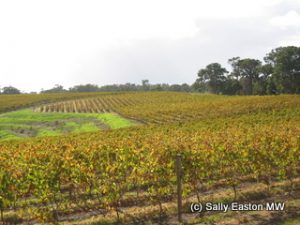Texture, structure, savouriness and sense of place – the new Aussie mantra

L-R: Jeff Clarke, Louisa Rose, Iain Riggs, Virginia Willcock, Matthew Jukes, Clive Jones, Tom Barry
The bywords for the next generation of Aussie winemakers look set to be texture, structure, savouriness and sense of place, (the French would call it terroir), as producers look to express greater individuality in their wines. They’ve cottoned on to the fact that the patch of dirt where the vines grow, and its complete environment, really is the thing that can’t be replicated elsewhere.
These were some of the words frequently occurring at a tasting and workshop event put on by wine company Negociants, who own or represent all the producers mentioned. – their first “winemaker tour”. (see later post specifically about viognier/Yalumba with Louisa Rose.)
For Jeff Clarke, the chief winemaker at Ara Wines this includes an element of ageworthiness for Marlborough sauvignon blanc. He said “we’re not changing the basic format of sauvignon blanc that we’ve been making, but now the big evolution is to start looking at wine styles that can last the length of time, wines more suited to go with food.” This involves a move to different vineyard sites he said “we’re trying to find sites in Marlborough that deliver more concentration and weight [in order to] get more texture and structure in the wines.” He’s pretty sure the Southern Valleys, where there is more clay in the soil, and the Awatere Valley, are the places to have vines.
Clive Jones, the chief winemaker at Nautilus Estate agreed, saying “clay soil gives succulence and flesh across the mid-palate” of his pinot noir. Added to which they’ve moved towards mixed clonal plantings and mixed clone fermentations. He said “these days, we ferment clones together, getting some sort of co-fermentation thing going on.”

Western Australia
In Western Australia, savouriness was the watchword for Virginia Willcock, chief winemaker at Vasse Felix: “we’re embracing the savoury elements of a wine, this is one of the things that is evolving. It’s now about allowing savoury characters to come through – the individuality of a wine comes from the soil and the environment.” Chardonnay, she added, “is one of the most beautiful grape varieties to do that.”
Some of this is achieved by “dirty” winemaking, up ‘til now complete anathema to Aussie winemaking philosophy. Willcock said “in the last 4-5 years we’re putting juice to barrel a lot dirtier that we used to, embracing more solids, which come from the vineyard.” It means they get more sulphides produced during fermentation, so the wine stinks a bit, but, she said “we’re patient, we don’t rack it, we let it go, and eventually it becomes part of the wine.”
Part of those solids from the vineyard include indigenous yeasts which carry out the fermentation, which at Vasse Felix give “funky, lamb fat, mushroom” notes.
The whole site specificity/terroir thing is interesting for Iain Riggs, the chief winemaker at Brokenwood, because “the Hunter really shouldn’t be growing grapes, it’s sub-tropical and we get most of our rainfall at vintage.” But, he said “after a hundred years of winemaking, we’ve settled on shiraz and semillon.” Both make unique and delicious styles, which is pretty much the definition of a sense of place.
Riggs explained “we don’t get our grapes very ripe, the reds are mostly 13/13.5%. We don’t have big alcohol, or density of colour.” Which makes shiraz notably different from other places, and creates a Hunter Valley shiraz style that is “about subtleness, elegance, finesse and structure that doesn’t jag any part of the palate.” It works in the Hunter.
Tasting notes, London, Sep 20, 2012
Ara, Resolute Sauvignon Blanc 2011, Marlborough, New Zealand
Positive hints of methoxypyrazine (green pepper) on the nose with gooseberry, sherbet and a tropical note. Palate is fresh, with some creaminess to the palate attack, (later confirmed as a 10% proportion in oak for 3 months) which rounds out the texture. Bit better than your average sauvignon blanc, but less overtly aromatic, with warm kick of white pepper spice at the back palate. Doesn’t seem to have huge concentration or guts, so could be more delicate in style, though I feel it’s dilute rather than delicate. I’m having a bit of an emperor’s new clothes moment with this wine.
Vasse Felix, Heytesbury Chardonnay 2010, Margaret River, Western Australia
Creamy, mealy, white-nutty nose, erring to sophisticated and enticing. Smooth silky palate attack, rich and warming, lovely mid-palate texture. Nuttiness gives way to sweet/leesy-cream note. This I think is delicate with some nice characters coming through, and a palate that fills out in the mouth. Nicely balanced wine, with notable refinement.
Yalumba, The Virgilius Viognier 2009, Eden Valley, South Australia
Restrained nose, floral notes with peachy, stone fruit aromatics. Medium body mid palate, warming to the back palate, with a rich, linear profile that lingers in the mouth. Plush, sophisticated and integrated. It has substance, density, linearity, and is delicious. Has fruit intensity with layers of non-fruity stuff; fresh but clearly not high acid, maybe freshness from a few ripe phenolics. Vg.
Nautilus Estate, Pinot Noir 2010, Marlborough, New Zealand
Pale translucent ruby colour. Nose rather muted, palate smooth, crunchy-fresh, cranberry and strawberry. Nice lines in a straight down the line sort of way. Not especially complex, focus is on primary fruit, with good intensity and bright vibrancy of those red fruits in the mid palate. Nicely balanced and proportioned in a straightforward way.
Brokenwood, Graveyard vineyard, Hunter Valley Shiraz 2009
Medium deep ruby colour. Silky, soft red berry fruits on nose. Aromatically tarry palate attack with sweet, crunchy red cherry notes, elegance and in-palate length, freshness from chalky tannins. Very long finish. Vg.
Jim Barry, The Armagh, Clare Valley, Shiraz 2007
Spicy, menthol nose with dark cherries. Smooth attack, then dark spices hit the palate (in a good way). Big, powerful, gutsy, with succulent ripe forest berry fruits, and dark charriness mid palate, with roasted fruits with hints of raisined fruits. Big with powerful, deep, long flavours.



